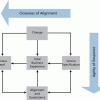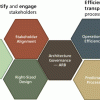Strategic advice to leverage new technologies
Technology is at the heart of nearly every enterprise, enabling new business models and strategies, and serving as the catalyst to industry convergence. Leveraging the right technology can improve business outcomes, providing intelligence and insights that help you make more informed and accurate decisions. From finding patterns in data through data science, to curating relevant insights with data analytics, to the predictive abilities and innumerable applications of AI, to solving challenging business problems with ML, NLP, and knowledge graphs, technology has brought decision-making to a more intelligent level. Keep pace with the technology trends, opportunities, applications, and real-world use cases that will move your organization closer to its transformation and business goals.
Recently Published
Characterizing projects by innovation is useful because it sheds light on the nature of work to be done no matter what the size of the effort.
There are many bookish definitions of architecture out there that speak of systems and components swirling around in complex interactions, and of the need to describe the organization, structures, patterns, and principles that underlie the dynamics of all this. The task of understanding and describing falls squarely on the architect's shoulders. But architects do more than description; architects also create new patterns of organization, intended to enable a move toward a better state for the business.
Fishing in the Data Lake
In the era of big data, where assumptions are being challenged in all areas related to analytic processing, it is no surprise that new concepts should emerge to challenge the central role of the data warehouse in BI. The most recent is the data lake, which is viewed as a centralized repository of unstructured data held for processing by Hadoop and meeting the diverse needs of big data analysis. The data lake, like so many concepts in our industry, is currently undergoing subtle change as new technologies evolve to extend, fortify, and capitalize on the need that it is designed to fill.
David Miller and Mark Woodman sketch out the Business and IT Relationship Model (BITRM) They introduce important concepts related to agility, governance, and management, tying it all together in the BITRM to prompt a change in the way we think about the nature of the business-IT union. This in turn leads to a new IT delivery model and a new way of IT management based on a total business experience.
This article highlights a visible and real force -- Agile -- that is sometimes at odds with the notion of architecture. Author Daniel Horton, an Agile practitioner, speaks from experience, pointing out how architecture is sometimes completely absent from Agile projects. He also discusses situations where architecture exists but may as well not, seeming to operate in a parallel universe of its own.
This article tackles the how-to of architecture governance. Mohan Babu K provides a veritable cookbook, chock full of frameworks and matrices, to help enterprises think through the various aspects of setting up an architecture review board, which is one of the most important components of architecture governance. Along the way, he draws out lessons from an actual implementation that he carried out for his company. If you are looking to set up or review your architecture review board, this article provides valuable guidance.
This article starts with a view of the digital society that is emerging and paints a picture of a "new style of IT." How can architecture deal with all this disruption? Peter Beijer describes the changes needed in the architecture function, in the discipline, and in the very profession itself. His article underscores that business architecture is an imperative, that a common language is needed to bridge the business-IT divide, and that architecture needs to be refocused as "a strategic instrument."














